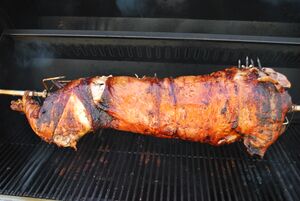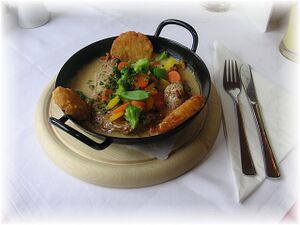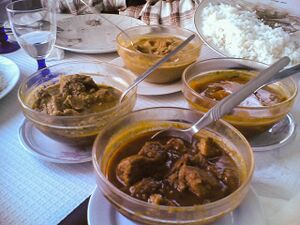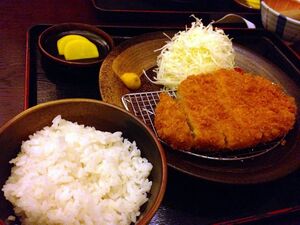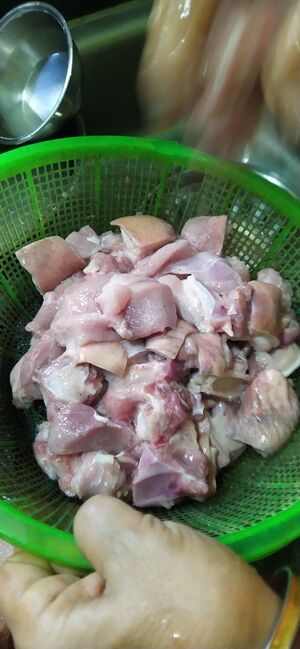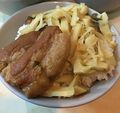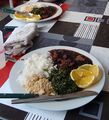لحم الخنزير

لحم الخنزير (إنگليزية: Pork)، هو نوع من اللحوم يستخلص من الخنزير.It is the most commonly consumed meat worldwide,[1] with evidence of pig husbandry dating back to 5000 BCE.[2]
Pork is eaten both freshly cooked and preserved; curing extends the shelf life of pork products. Ham, gammon, bacon, and sausage are examples of preserved pork. Charcuterie is the branch of cooking devoted to prepared meat products, many from pork.
Pork is the most popular meat in the Western world, particularly in Central Europe. It is also very popular in East and Southeast Asia (Mainland Southeast Asia, Philippines, Singapore, and East Timor). The meat is highly prized in Asian cuisines, especially in China (including Hong Kong), for its fat content and texture.
Some religions and cultures prohibit pork consumption, notably Islam and Judaism.
History
This section requires expansion. (April 2023) |
Pigs were domesticated in Mesopotamia around 13,000 BC.[3]
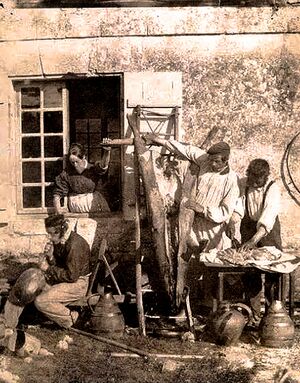
Charcuterie is the branch of cooking devoted to prepared meat products such as bacon, ham, sausage, terrines, galantines, pâtés and confit, primarily from pig.[4] Originally intended as a way to preserve meats before the advent of refrigeration, these preparations are prepared today for the flavors that are derived from the preservation processes.[5] In 15th-century France, local guilds regulated tradesmen in the food production industry in each city. The guilds that produced charcuterie were those of the charcutiers. The members of this guild produced a traditional range of cooked or salted and dried meats, which varied, sometimes distinctively, from region to region. The only "raw" meat the charcutiers were allowed to sell was unrendered lard. The charcutier prepared numerous items, including pâtés, rillettes, sausages, bacon, trotters, and head cheese.[بحاجة لمصدر]
Before the mass production and re-engineering of pigs in the 20th century, pork in Europe and North America was traditionally an autumn dish—pigs and other livestock coming to the slaughter in the autumn after growing in the spring and fattening during the summer. Due to the seasonal nature of the meat in Western culinary history, apples (harvested in late summer and autumn) have been a staple pairing to fresh pork. The year-round availability of meat and fruits has not diminished the popularity of this combination on Western plates.[6]
Consumption patterns
Pigs are the most widely eaten animal in the world, accounting for about 36% of meat production worldwide.[7] As a result, large numbers of pork recipes have been developed throughout the world. Jamón, made from the hind legs of a pig, is the most well-known Spanish dry-cured ham. Feijoada, the national dish of Brazil (also served in Portugal), is traditionally prepared with pork trimmings: ears, tail and feet.[8]
According to the USDA's Foreign Agricultural Service, nearly 100 million metric tons of pork were consumed worldwide in 2006 (preliminary data). Increasing urbanization and disposable income has led to an uprising in pork consumption in China, where 2006 consumption was 20% higher than in 2002, and a further 5% increase projected in 2007.[9] In 2015 recorded total 109.905 million metric tons of pork were consumed worldwide.[10] By 2017, half the world's pork was consumed in China.[11]
Worldwide pork consumption
| Country | 2009 | 2010 | 2011 | 2012 | 2013 | 2014 | 2015 | 2016 |
|---|---|---|---|---|---|---|---|---|
| China | 48,823 | 51,160 | 50,004 | 52,725 | 54,250 | 57,195 | 56,668 | 54,070 |
Europe Austria Belgium Bulgaria Cyprus Czech Republic Denmark Estonia Finland France Germany Greece Hungary Ireland Italy Latvia Lithuania Luxembourg Malta Netherlands Poland Portugal Romania Slovakia Slovenia Spain Sweden United Kingdom Croatia |
20,691 | 20,952 | 20,821 | 20,375 | 20,268 | 20,390 | 20,913 | 20,062 |
| United States | 9,013 | 8,654 | 8,340 | 8,441 | 8,616 | 8,545 | 9,341 | 9,452 |
| Russia | 2,719 | 2,835 | 2,971 | 3,145 | 3,090 | 3,024 | 3,016 | 3,160 |
| Brazil | 2,423 | 2,577 | 2,644 | 2,670 | 2,771 | 2,845 | 2,893 | 2,811 |
| Japan | 2,467 | 2,488 | 2,522 | 2,557 | 2,553 | 2,543 | 2,568 | 2,590 |
| Vietnam | 2,071 | 2,072 | 2,113 | 2,160 | 2,205 | 2,408 | 2,456 | 2,506 |
| Mexico | 1,770 | 1,784 | 1,710 | 1,850 | 1,945 | 1,991 | 2,176 | 2,270 |
| South Korea | 1,480 | 1,539 | 1,487 | 1,546 | 1,598 | 1,660 | 1,813 | 1,868 |
| Philippines | 1,356 | 1,418 | 1,432 | 1,446 | 1,533 | 1,551 | 1,544 | 1,659 |
| Ukraine | 713 | 776 | 806 | 953 | 1,006 | {{N/A}} | {{N/A}} | {{N/A}} |
| Taiwan | 925 | 901 | 919 | 906 | 892 | 875 | 930 | 897 |
| Canada | 853 | 802 | 785 | 834 | 837 | {{N/A}} | {{N/A}} | {{N/A}} |
| Hong Kong | 486 | 467 | 558 | 547 | 537 | {{N/A}} | {{N/A}} | {{N/A}} |
| Australia | 464 | 482 | 482 | 511 | 528 | {{N/A}} | {{N/A}} | {{N/A}} |
| Chile | 369 | 385 | 408 | 430 | 430 | {{N/A}} | {{N/A}} | {{N/A}} |
| Others | 3,615 | 3,756 | 3,932 | 4,022 | 4,183 | 6,869 | 6,587 | 6,656 |
| Total | 100,238 | 103,045 | 101,934 | 105,118 | 107,242 | 109,896 | 109,095 | 108,001 |
| In metric tons ('000s), Source: USDA reports, 2009–2013 figures,[12] 2014–2016 figures[10] | ||||||||
Asian pork consumption
Pork is popular throughout eastern Asia and the Pacific, where whole roast pig is a popular item in Pacific Island cuisine. It is consumed in a great many ways and highly esteemed in Chinese cuisine.[13] Currently China is the world's largest pork consumer, with pork consumption expected to total 53 million metric tons in 2012, which accounts for more than half of global pork consumption.[14] In China, pork is preferred over beef for economic and aesthetic reasons; the pig is easy to feed and is not used for labour. The colours of the meat and the fat of pork are regarded as more appetizing, while the taste and smell are described as sweeter and cleaner. It is also considered easier to digest.[15] In rural tradition, pork is shared to celebrate important occasions and to form bonding. In China, pork is so important that the nation maintains a "strategic pork reserve".[16] Red braised pork (hong shao rou), a delicacy from Hunan Province, was one of Mao Zedong's favorite dishes.[17] Other popular Chinese pork dishes are sweet and sour pork, bakkwa, and charsiu. In the Philippines, due to 300 years of Spanish colonization and influence, lechon, which is an entire roasted suckling pig, is a national delicacy.[بحاجة لمصدر]
Production by country
China was the largest producer of pork in the world in 2020 followed by the European Union and the United States.
China, EU and the United States accounted for roughly 76% of the world's pork production as per FAS/USDA[18]
| Rank | Countries | 2020 (Metric tons) | % of World |
|---|---|---|---|
| 1 | China | 36,340,000 | 37.58% |
| 2 | European Union | 24,150,000 | 24.97% |
| 3 | United States | 12,843,000 | 13.28% |
| 4 | Brazil | 4,125,000 | 4.27% |
| 5 | Russia | 3,611,000 | 3.73% |
| 6 | Philippines | 2,467,000 | 2.55% |
| 7 | Canada | 2,130,000 | 2.20% |
| 8 | Mexico | 1,451,000 | 1.50% |
| 9 | South Korea | 1,403,000 | 1.45% |
| 10 | Japan | 1,298,000 | 1.34% |
Pork products
هذا القسم يحتاج المزيد من الأسانيد للتحقق. (July 2021) (Learn how and when to remove this template message) |
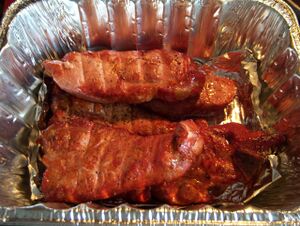
Pork may be cooked from fresh meat or cured over time. Cured meat products include ham and bacon. The carcass may be used in many different ways for fresh meat cuts, with the popularity of certain cuts varying worldwide.
Fresh meat
Most of the pig can be used to produce fresh meat and, in the case of a suckling pig, the whole body of a young pig ranging in age from two to six weeks is roasted. Danish roast pork or flæskesteg, prepared with crispy crackling is a national favourite as the traditional Christmas dinner.[19]
Processed pork
Pork is particularly common as an ingredient in sausages. Many traditional European sausages are made with pork, including chorizo, fuet, Cumberland sausage and salami giving it a succulent finish. Many brands of American hot dogs and most breakfast sausages are made from pork. Processing of pork into sausages and other products in France is described as charcuterie.
Ham and bacon are made from fresh pork by curing with salt (pickling) or smoking. Shoulders and legs are most commonly cured in this manner for Picnic shoulder and ham, whereas streaky and round bacon come from the side (round from the loin and streaky from the belly).[20]
Ham and bacon are popular foods in the west, and their consumption has increased with industrialisation. Non-western cuisines also use preserved meat products. For example, salted preserved pork or red roasted pork is used in Chinese and Asian cuisine.
Bacon
Bacon is defined as any of certain cuts of meat taken from the sides, belly, or back that have been cured or smoked. In continental Europe, it is used primarily in cubes (lardons) as a cooking ingredient valued both as a source of fat and for its flavour. In Italy, besides being used in cooking, bacon (pancetta) is also served uncooked and thinly sliced as part of an antipasto. Bacon is also used for barding roasts, especially game birds. Bacon is often smoked with various wood fuels for up to ten hours. Bacon is eaten fried, baked, or grilled.
A side of unsliced bacon is a "flitch" or "slab bacon", while an individual slice of bacon is a "rasher" (Australia, Ireland, New Zealand and the United Kingdom) or simply a "slice" or "strip" (North America). Slices of bacon are also known as "collops". Traditionally, the skin is left on the cut and is known as "bacon rind". Rindless bacon, however, is quite common. In both Ireland and the United Kingdom, bacon comes in a wide variety of cuts and flavours, and is predominantly known as "streaky bacon", or "streaky rashers". Bacon made from the meat on the back of the pig is referred to as "back bacon" and is part of traditional full breakfasts commonly eaten in Britain and Ireland. In the United States, back bacon may also be referred to as "Canadian-style Bacon" or "Canadian Bacon".[21]
The canned meat Spam is made of chopped pork shoulder meat and ham.
Industrial raw material
Due to the fact that pigs can eat unused food originally meant for humans, and due to the high availability of such food in many industrialized countries, pork and other products from pigs have become securely sourced and low-priced commodities. This makes pig products very popular as raw material in many industrially produced products.[بحاجة لمصدر]
Cuts
Nutrition
| القيمة الغذائية لكل 100 g (3.5 oz) | |
|---|---|
| الطاقة | 1،013 kJ (242 kcal) |
0.00 g | |
| Sugars | 0.00 g |
| ألياف غذائية | 0.0 g |
27.92 g | |
| مشبع | 5.230 g |
| أحادي عدم التشبع | 6.190 g |
| متعدد عدم التشبع | 1.200 g |
13.32 g | |
| Tryptophan | 0.338 g |
| Threonine | 1.234 g |
| Isoleucine | 1.260 g |
| Leucine | 2.177 g |
| Lysine | 2.446 g |
| Methionine | 0.712 g |
| Cystine | 0.344 g |
| Phenylalanine | 1.086 g |
| Tyrosine | 0.936 g |
| Valine | 1.473 g |
| Arginine | 1.723 g |
| Histidine | 1.067 g |
| Alanine | 1.603 g |
| Aspartic acid | 2.512 g |
| Glutamic acid | 4.215 g |
| Glycine | 1.409 g |
| Proline | 1.158 g |
| سرين | 1.128 g |
| الڤيتامينات | |
| ڤيتامين B6 | (36%) 0.464 mg |
| ڤيتامين ب12 | (29%) 0.70 μg |
| Choline | (19%) 93.9 mg |
| Vitamin C | (1%) 0.6 mg |
| ڤيتامين د | (9%) 53 IU |
| آثار فلزات | |
| كالسيوم | (2%) 19 mg |
| حديد | (7%) 0.87 mg |
| الماغنسيوم | (8%) 28 mg |
| فوسفور | (35%) 246 mg |
| پوتاسيوم | (9%) 423 mg |
| صوديوم | (4%) 62 mg |
| زنك | (25%) 2.39 mg |
| مكونات أخرى | |
| ماء | 57.87 g |
| |
| Percentages are roughly approximated using US recommendations for adults. Source: USDA Nutrient Database | |
Its myoglobin content is lower than that of beef, but much higher than that of chicken, so the USDA treats pork as a red meat.[22] In 1987, the U.S. National Pork Board began an advertising campaign to position pork as "the other white meat"—due to a public perception of chicken and turkey (white meat) as healthier than red meat. The campaign was highly successful and resulted in 87% of consumers identifying pork with the slogan. The board retired the slogan on 4 March 2011.[23]
Pork is very high in thiamin (vitamin B1).[24][25][26][27] Pork with its fat trimmed is leaner than the meat of most domesticated animals, but is high in cholesterol and saturated fat.
Religious beliefs
Eating of pork is prohibited by orthodox Jewish dietary laws and Islamic dietary laws, and is also avoided by mainstream Seventh-day Adventists, Rastafarians, and members of the Ethiopian Orthodox Tewahedo Church. There is also a theory that pork was taboo in Scotland until roughly 1800.[بحاجة لمصدر]
Judaism
Pork is a well-known example of a non-kosher food. This prohibition is based on Leviticus chapter 11 and Deuteronomy chapter 14:
These are the creatures that you may eat from among all the animals that are upon the land. Everything that possesses a split hoof, which is fully cloven, and that brings up its cud—this you may eat. But this is what you shall not eat from what brings up its cud or possesses split hooves—the camel, because it brings up its cud but does not possess split hooves...and the pig, because it has split hooves that are completely cloven, but it does not bring up its cud—it is impure to you and from its flesh you may not eat.
- —Leviticus 11:2–4, 7–8
And the pig, because it possesses split hooves and does not bring up its cud—from its flesh you may not eat.
- —Deuteronomy 14:8
As indicated by the Torah verses, pork is non-kosher because Jews may not consume an animal that possesses one trait but not the other of cloven hooves and regurgitating cud. Hogs, which are not ruminants, do not chew cud as cattle and sheep do. Practicing Jews suffice on the biblical explanation of the swine as 'unclean'. Maimonides shared this view in classifying the swine as an unclean creature in both its habit and diet.[28]
The prohibition of swine-eating in Ancient Israelite cuisine, according to Douglas, was because the pig was raised by non-Israelites, ate carrion and did not fit into the classification of ungulates. Harris disagrees and points out that Egyptians and Sumerians also restricted pigs and that goats also ate corpses, yet were not declared unclean in Ancient Israel. Harris offers an explanation based on environmental and economic factors instead.[29]
In Israel, pig-raising has been limited by law to certain areas and institutions.[30][31] Some pig-related laws are openly circumvented.[32] Swine production has increased from an estimated annual slaughter of 50,000 swine in 1960[30] to 180,000 in 2010.[33] Pig meat consumption per capita was 2.7 kg in 2009.[34] Although pork marketing is prohibited in some religious localities,[31] pork products are available elsewhere at non-kosher butchers and by the Mizra and Tiv Ta'am non-kosher supermarket chain, which caters to Russian immigrants.[35] A modern Hebrew euphemism for pork is "white meat".[35]
Islam
Pork meat is prohibited by the Islamic dietary laws. Throughout the Islamic world many countries severely restrict the importation or consumption of pork products. Examples are Iran,[36] Mauritania,[37] Oman,[38] Qatar,[39] Saudi Arabia, Algeria, Turkmenistan, Uzbekistan, Tajikistan, Yemen, Somalia, Sudan, Afghanistan, Djibouti, Kuwait, Mali, Niger, Senegal, Gambia, Libya, Pakistan (except in some communities) and the Maldives.[40] However, in other Muslim-majority countries with significant non-Muslim minorities, such as Indonesia (except the province of Aceh), Malaysia, Brunei, Lebanon, Iraq[بحاجة لمصدر], Tunisia, Egypt, Morocco, Bahrain, Bangladesh, Kyrgyzstan, Kazakhstan, Jordan, Albania, Azerbaijan, Turkey, Bosnia and Herzegovina, Kosovo, Syria, Sierra Leone, Guinea, Chad and the United Arab Emirates (except the Emirate of Sharjah), pork is available in hotels, restaurants and supermarkets that cater to a significant non-Muslim population.[41]
The Qur'anic basis for the Islamic prohibition of pork can be found in surah 2:173, 5:3, 5:60, 6:145 and 16:115.[42][43][44][45][46]
He has forbidden you only the carrion, blood, and the flesh of swine, and that which is slaughtered as a sacrifice for others than God. But if one is forced by necessity, without wilful disobedience, nor transgressing due limits, then there is no sin on him. Truly, Allah is Oft-forgiving Most Merciful.
- —Chapter (Sura) 2 – Verse (Ayat) 173 Al-Baqara (The Cow)
Forbidden for you for food are carrion, blood, flesh of swine, and that which has been dedicated to other than God, and animals killed by strangling or by a violent blow or by a head-long fall or by the goring of horns, and those from which a wild animal has eaten, except what you [are able to] slaughter [before its death], and those which are sacrificed on stone altars, and [prohibited is] that you seek decision through divining arrows. That is grave disobedience. This day those who disbelieve have despaired of [defeating] your religion; so fear them not, but fear Me. This day I have perfected for you your religion and completed My favor upon you and have approved for you Islam as religion. But whoever is forced by severe hunger with no inclination to sin – then indeed, Allah is Forgiving and Merciful.
- —Chapter (Sura) 5 – Verse (Ayat) 3 Al-Maidah (The Table Spread)
I do not find within that which was revealed to me [anything] forbidden to one who would eat it unless it be a dead animal or blood spilled out or the flesh of swine - for indeed, it is impure - or it be [that slaughtered in] disobedience, dedicated to other than Allah. But whoever is forced [by necessity], neither desiring [it] nor transgressing [its limit], then indeed, your Lord is Forgiving and Merciful.
- —Chapter (Sura) 6 – Verse (Ayat) 145 Al-An'am (The Cattle)
He has only forbidden to you dead animals, blood, the flesh of swine, and that which has been dedicated to other than Allah. But whoever is forced [by necessity], neither desiring [it] nor transgressing [its limit] - then indeed, Allah is Forgiving and Merciful.
- —Chapter (Sura) 16 – Verse (Ayat) 115 An-Nahl (The Bees)
Christianity
While most sects of Christianity allow the consumption of pork, some sects prohibit it based on Leviticus chapter 11, Deuteronomy chapter 14, and Isaiah chapters 65 and 66. Some denominations that forbid pork consumption are:[بحاجة لمصدر]
- Ethiopian Orthodox Tewahedo Church
- Hebrew Roots
- Messianic Judaism
- Seventh-day Adventists
- United Church of God
- Sacred Name Movement
When pork was not included on the menu of the Liverpool Council's first Christian Orthodox Interfaith lunch some members of the Macedonian Orthodox community objected, citing the historical significance of the dish to the community during the Ottoman era and raising complaints that the council was discriminating against Orthodox Christians. A spokeswoman for the council explained that the council had not prepared a pork menu option because Muslims, Jews and Hindus do not consume pork and it had seemed inconsistent with the purpose of bringing together persons of different faiths, though after the complaints raised by the Orthodox community a pork alternative was added.[47]
Disease in pork

Pork is known to carry some diseases such as pork tapeworm and trichinosis and pigbel, thus uncooked or undercooked pork can be dangerous to consume, although raw pork products are sometimes still consumed in Central European and Eastern European countries of which the Eastern European countries are believed to have a higher risk of trichinosis.[48][49]
Undercooked or untreated pork may harbour pathogens, or can be recontaminated after cooking if left exposed for a long period of time. In one instance, the Food Safety and Inspection Service (FSIS) detected Listeria monocytogenes in 210 kg (460 lb) of Polidori brand fully cooked pork sausage crumbles, although no one was made ill from consumption of the product.[50] The FSIS has previously stated that listeria and other microorganisms must be "...destroyed by proper handling and thorough cooking to an internal temperature of 71 °C (160 °F)," and that other microorganisms, such as E. coli, Salmonella, and Staphylococcus aureus can be found in inadequately cooked pork, poultry, and other meats.[51] The FSIS, a part of the USDA, currently recommends cooking ground pork to 71 °C (160 °F) and whole cuts to 63 °C (145 °F) followed by a 3-minute rest.[52]
Pigs can be carriers of various helminths, such as roundworms, pinworms, hookworms. One of the more common is Taenia solium, a type of tapeworm, which may transplant to the intestines of humans after consuming undercooked meat.[بحاجة لمصدر] Raw and undercooked pork can also cause other diseases, such as toxoplasmosis.
Although not a common cause of illness, Yersinia enterocolitica—which causes gastroenteritis—is present in various foods, but is most frequently caused by eating uncooked or undercooked pork and can grow in refrigerated conditions. The bacteria can be killed by heat.[53] Nearly all outbreaks in the US have been traced to pork.[54]
Pork may be the reservoir responsible for sporadic, locally acquired cases of acute hepatitis E (HEV) reported in regions with relatively mild climates. It has been found to transmit between swine and humans.[55]
Trichinosis, also called trichinellosis, or trichiniasis, is a parasitic disease caused by eating raw or undercooked pork infected with the larvae of a species of roundworm Trichinella spiralis, commonly called the trichina worm. Infection was once very common, but is now rare in the developed world. From 2002 to 2007, an annual average of 11 cases per year were reported in the United States; the majority were from consuming wild game or the source was unknown. The number of cases has decreased because of legislation prohibiting the feeding of raw meat garbage to hogs, increased commercial and home freezing of pork, and the public awareness of the danger of eating raw or undercooked pork or wild game products.[56]
Gallery of dishes
Grilled pork as a main dish on a Serbian Christmas table.
Sweet and sour pork, a Chinese dish that is popular in Europe and Americas.
Red-colored char siu is one of the popular ways to prepare pork in Southern China.
Chinese Dongpo pork
Chinese Dongpo pork
Chinese Braised pork rice
Chinese Minced pork rice
Khao mu krop mu daeng, Thai crispy and red pork.
Bak kut teh, the pork ribs and offal soup, of Malaysia and Singapore.
Batak-style Babi panggang, roasted pork belly of Indonesia.
Filet de Porc à la Bordelaise, a French-style pork tenderloin.
Feijoada, typical Portuguese pork with beans, is the national dish of Brazil.
Chicharrón, Spanish fried pork rinds, widely distributed throughout Hispanic world.
Lechón being roasted in Cadiz City, Philippines.
Porcheddu, Sardinian suckling pig.
Steam Pork with Salted fish
See also
References
- ^ "Sources of Meat". Food and Agriculture Organization (FAO). 25 November 2014. Archived from the original on 2 March 2018. Retrieved 19 November 2016.
- ^ Crabtree, Pam J.; Campana, Douglas V.; Ryan, Kathleen (1989). Early Animal Domestication and Its Cultural Context (in الإنجليزية). UPenn Museum of Archaeology. ISBN 978-0-924171-96-3. Archived from the original on 6 February 2021. Retrieved 19 October 2020.
- ^ Nelson, Sarah M. (1998). Ancestors for the Pigs. Pigs in prehistory. University of Pennsylvania Museum of Archaeology and Anthropology. ISBN 9781931707091. Archived from the original on 1 August 2020. Retrieved 25 April 2020.
- ^ Ruhlman, 18.; The Culinary Institute of America, 3.
- ^ Ruhlman, 19.
- ^ Thompson, Michael D., “‘Everything but the Squeal’: Pork as Culture in Eastern North Carolina,” North Carolina Historical Review, 82 (Oct. 2005), 464–98. Heavily illustrated.
- ^ "FAO's Animal Production and Health Division: Meat & Meat Products". Archived from the original on 2 March 2018. Retrieved 6 May 2014.
- ^ Brazilbrazil.com Archived 21 أغسطس 2008 at the Wayback Machine
- ^ "Livestock and Poultry: World Markets and Trade." Archived 28 سبتمبر 2007 at the Wayback Machine Circular Series DL&P 2-06, Foreign Agricultural Service, United States Department of Agriculture, October 2006. Retrieved on 15 August 2007.
- ^ أ ب Livestock and Poultry: World Markets and Trade. United States Department of Agriculture. October 2016. Archived from the original. You must specify the date the archive was made using the
|archivedate=parameter. http://apps.fas.usda.gov/psdonline/circulars/livestock_poultry.pdf. Retrieved on 1 August 2016. - ^ "China launches a pork-price index to smooth the "pig cycle"". The Economist. 21 April 2017. Archived from the original on 23 April 2017. Retrieved 23 April 2017.
- ^ Livestock and Poultry: World Markets and Trade. United States Department of Agriculture. November 2013. Archived from the original. You must specify the date the archive was made using the
|archivedate=parameter. http://apps.fas.usda.gov/psdonline/circulars/livestock_poultry.pdf. - ^ Solomon, Charmaine (1996). Encyclopedia of Asian Food. Melbourne: William Heinemann Australia. p. 288. ISBN 0-85561-688-1.
- ^ Mamta Badkar (29 May 2013). "14 Facts About The Staggeringly Huge Chinese Pork Industry". Business Insider. Archived from the original on 26 January 2016. Retrieved 31 July 2014.
- ^ Tropp, Barbara (1982). The Modern Art of Chinese Cooking. New York: Hearst Books. p. 183. ISBN 0-688-14611-2.
- ^ Wines, Michael (15 July 2011). "China Plans to Release Some of Its Pork Stockpile to Hold Down Prices". The New York Times. Archived from the original on 16 December 2013. Retrieved 15 November 2013.
- ^ Moore, Malcolm (29 January 2010). "China sets standard for Chairman Mao's favourite dish". The Daily Telegraph. Archived from the original on 16 October 2016. Retrieved 23 April 2014.
- ^ "Ranking Of Countries That Produce The Most Pork (USDA)". beef2live.com (in الإنجليزية). Retrieved 15 February 2022.
- ^ "Danish Christmas dinner" Archived 17 سبتمبر 2019 at the Wayback Machine, Wonderful Denmark. Retrieved 17 December 2011.
- ^ Ruhlman, Michael and Polcyn, Brian. Charcuterie: The Craft of Salting, Smoking and Curing. New York: W.W Norton & Company, 2008. ISBN 978-0-393-05829-1
- ^ Cattleman's Beef Board & National Cattlemen's Beef Association. Uniform Retail Meat Identity Standards Archived 27 مارس 2009 at the Wayback Machine. Retrieved 11 July 2007.
- ^ Fresh Pork...from Farm to Table Archived 14 يوليو 2007 at the Wayback Machine USDA Food Safety and Inspection Service.
- ^ "Pork board swaps 'White Meat' for 'Be Inspired'". Associated Press. 4 March 2011. Retrieved 8 March 2011.
- ^ "Calories in Pork, Fresh, Loin, Tenderloin". Calorie Count. Archived from the original on 6 September 2007. Retrieved 4 October 2007.
- ^ "Top 10 Foods Highest in Thiamin (Vitamin B1);
from google (thiamin source) result 1". Archived from the original on 15 March 2017. Retrieved 14 March 2017. - ^ "Table 2: Selected Food Sources of Thiamin [10];
from '(4)' in authoritynutrition.com/foods/pork/ ;
from google (pork nutrition value) result 1". Archived from the original on 30 December 2016. Retrieved 14 March 2017. - ^ "Thiamin: Unlike other types of red meat, such as beef and lamb, pork is particularly rich in thiamin. Thiamin is one of the B-vitamins and plays an essential role in various body functions (4);
from google (pork nutrition value) result 1". Archived from the original on 8 April 2015. - ^ Marvin Harris (1996). "The Abominable Pig". In Charles Edward Carter (ed.). Community, Identity, and Ideology: Social Science Approaches to the Hebrew Bible. Carol L. Meyers. Eisenbrauns. pp. 135–. ISBN 978-1-57506-005-7. Archived from the original on 19 August 2020. Retrieved 25 February 2018. See also Guy Darshan, (2022) “Pork Consumption as an Identity Marker in Ancient Israel: The Textual Evidence,” Journal for the Study of Judaism 53,4-5.
- ^ Society for Old Testament Study (21 November 1991). The World of Ancient Israel: Sociological, Anthropological and Political Perspectives. Cambridge University Press. pp. 33–. ISBN 978-0-521-42392-2. Archived from the original on 19 August 2020. Retrieved 25 February 2018.
- ^ أ ب Segev, Tom (27 January 2012). "The Makings of History / Pork and the people". HaAretz. Archived from the original on 28 June 2012. Retrieved 6 April 2013.
- ^ أ ب Barak-Erez, Daphne (2007). Outlawed Pigs: Law, Religion, and Culture in Israel. Univ of Wisconsin Press. ISBN 978-0-299-22160-7. Archived from the original on 16 June 2013. Retrieved 6 April 2013.
- ^ Concern for Helping Animals in Israel (CHAI). "Pigs FACTSHEET". Archived from the original on 10 May 2013. Retrieved 6 April 2013.
- ^ Food and Agriculture Organization of the United Nations. "FAOSTAT". Archived from the original on 11 May 2013. Retrieved 6 April 2013.
- ^ Food and Agriculture Organization of the United Nations. "FAOSTAT". Archived from the original on 19 January 2016. Retrieved 6 April 2013.
- ^ أ ب Yoskowitz, Jeffrey (24 April 2008). "On Israel's Only Jewish-Run Pig Farm, It's The Swine That Bring Home the Bacon – Letter From Kibbutz Lahav By April 24, 2008". Forward. Archived from the original on 19 April 2013. Retrieved 6 April 2013.
- ^ Travel Report for Iran Foreign Affairs and International Trade Canada. Archived 10 نوفمبر 2014 at the Wayback Machine
- ^ Travel Report for Mauritania Foreign Affairs and International Trade Canada. Archived 16 ديسمبر 2008 at the Wayback Machine
- ^ Travel Advice for Oman Archived 8 أكتوبر 2006 at the Wayback Machine Australian Department of Foreign Affairs and Trade
- ^ Travel Report for Qatar Foreign Affairs and International Trade Canada. Archived 20 ديسمبر 2008 at the Wayback Machine
- ^ Travel Report for Saudi Arabia Archived 26 أكتوبر 2007 at the Wayback Machine Foreign Affairs and International Trade Canada.
- ^ "Buying Pork in Dubai – ComingAnarchy.com". cominganarchy.com. Archived from the original on 30 November 2010. Retrieved 22 March 2013.
- ^ قالب:Cite Quran
- ^ قالب:Cite Quran
- ^ قالب:Cite Quran
- ^ قالب:Cite Quran
- ^ قالب:Cite Quran
- ^ O'Brien, Natalie (25 July 2015). "Liverpool Council upsets Orthodox community by leaving pork off the menu for interfaith lunch". The Sydney Morning Herald. Archived from the original on 26 July 2015. Retrieved 26 July 2015.
- ^ "Risk of trichinosis from locally produced raw sausages from Eastern Europe – BfR". bund.de. Archived from the original on 27 December 2014. Retrieved 27 December 2014.
- ^ Andrei, Mihai. Why is pork bad for you — a look at what the science says. ZME Science. Retrieved on 5 January 2022
- ^ "More meat recalls: pork sausage due to listeria contamination". 1 May 2010. Archived from the original on 2 July 2010. Retrieved 29 June 2010.
- ^ "Safety of Fresh Pork...from Farm to Table". Archived from the original on 9 July 2010. Retrieved 29 June 2010.
- ^ "Fresh Pork...from Farm to Table". Archived from the original on 18 September 2013. Retrieved 19 July 2013.
- ^ "Bacterial Food Poisoning". Archived from the original on 20 November 2012. Retrieved 29 June 2010.
- ^ "Food-Related Illness and Death in the United States". Retrieved 29 June 2010.
- ^ Satou, Kunio; Nishiura, Hiroshi (10 May 2007). "BMC Veterinary Research – Full text – Transmission dynamics of hepatitis E among swine: Potential impact upon human infection". BMC Veterinary Research. 3 (1): 9. doi:10.1186/1746-6148-3-9. PMC 1885244. PMID 17493260.
{{cite journal}}: CS1 maint: unflagged free DOI (link) - ^ "Trichinellosis Fact Sheet". Centers for Disease Control, US Government. 2004. Archived from the original on 20 December 2010. Retrieved 25 February 2011.
External links
- National Pork Board
- "Be inspired" - National Pork Board campaign
- National Pork Producers' Council
- Radio broadcast about pork production by Kootenay Co-op Radio Archived 14 مايو 2013 at the Wayback Machine
- Slovak Pork Slaughter and Traditional Sausage Making – article in English with detailed pictures of a Slovak family slaughtering a pig in 68 steps
- CS1 maint: unflagged free DOI
- Short description is different from Wikidata
- Articles containing إنگليزية-language text
- Pages using Lang-xx templates
- Articles with hatnote templates targeting a nonexistent page
- Articles to be expanded from April 2023
- All articles to be expanded
- مقالات ذات عبارات بحاجة لمصادر
- Articles needing additional references from July 2021
- All articles needing additional references
- Articles with unsourced statements from March 2020
- Articles with unsourced statements from January 2020
- Articles with unsourced statements from September 2013
- Pages with empty portal template
- Portal-inline template with redlinked portals
- لحم الخنزير
- Pork dishes
- Meat
- Meat by animal
